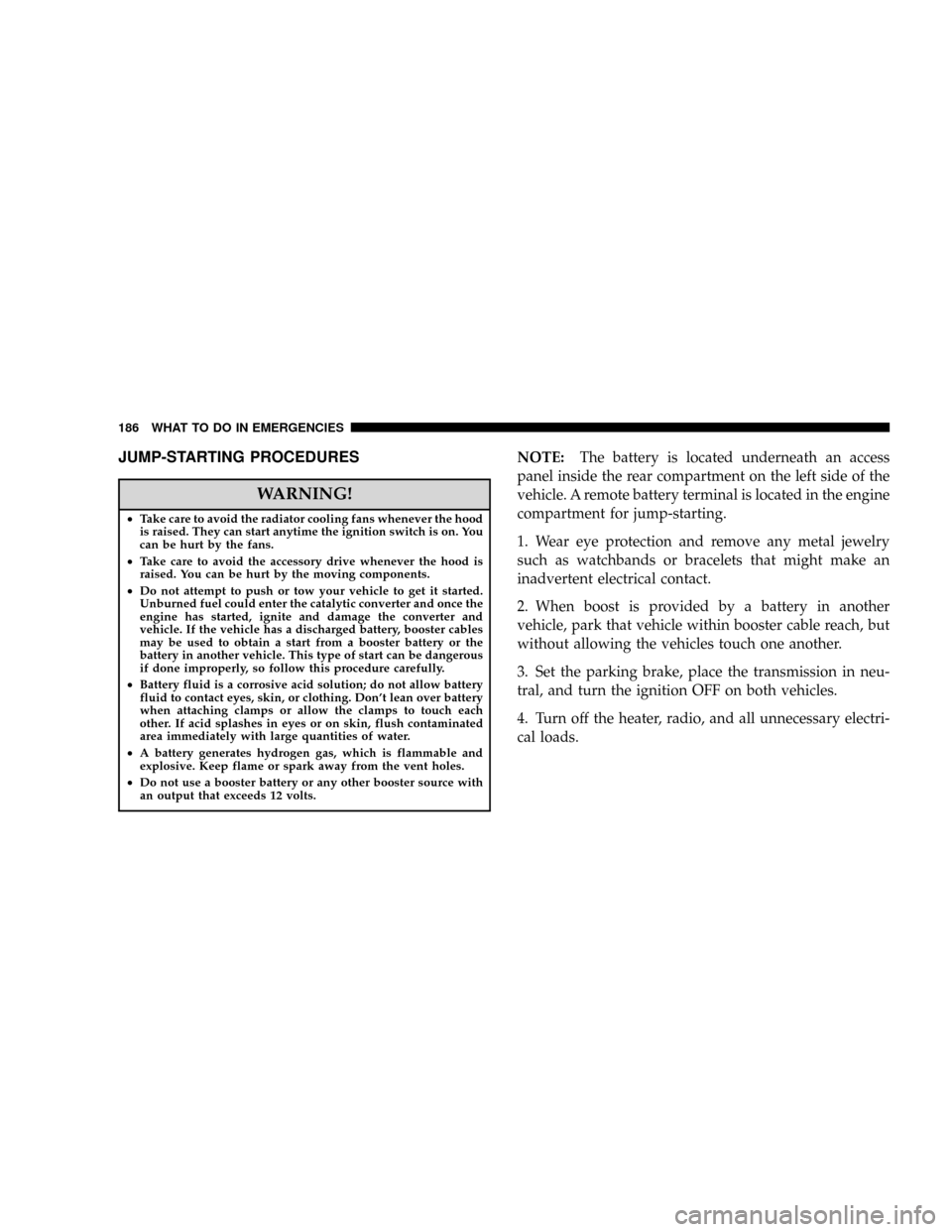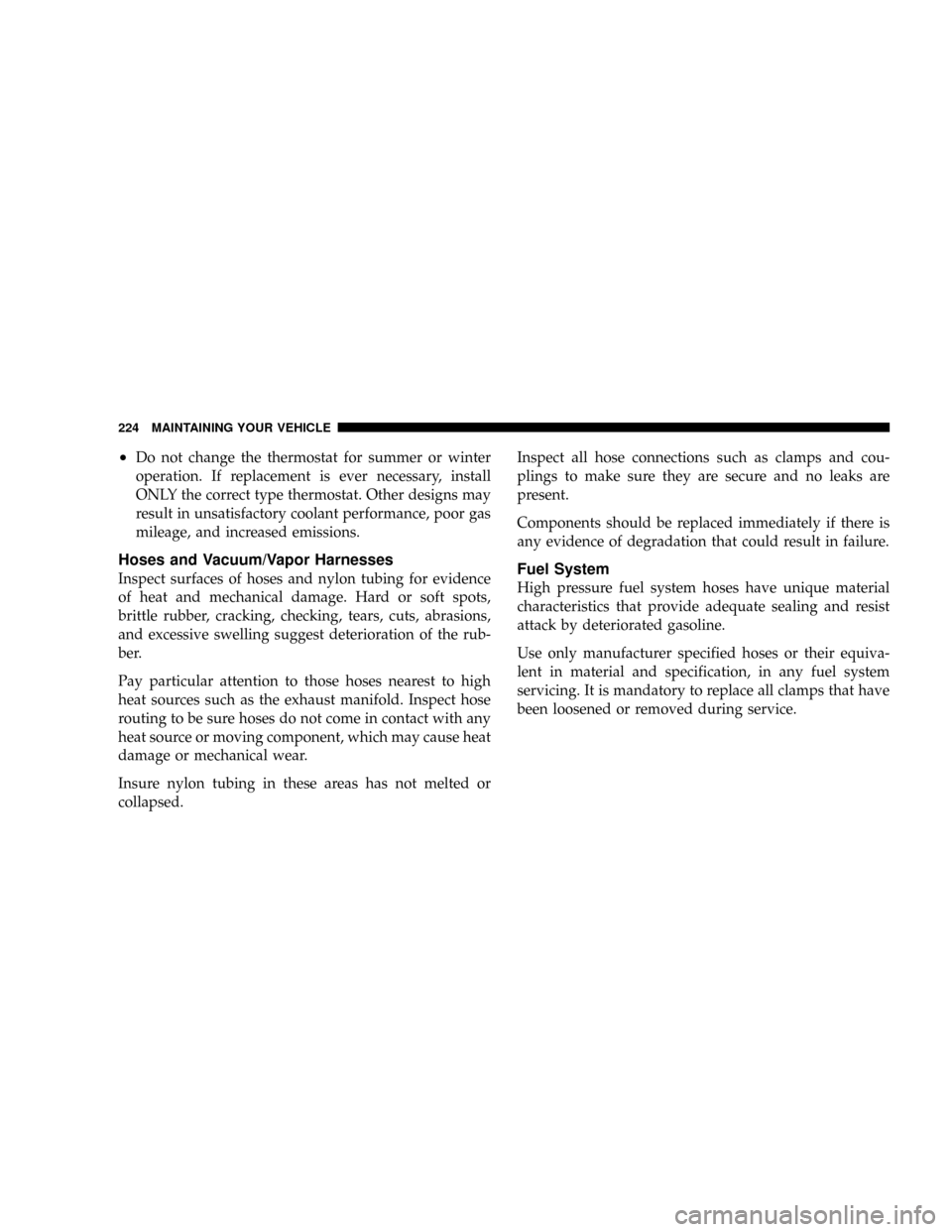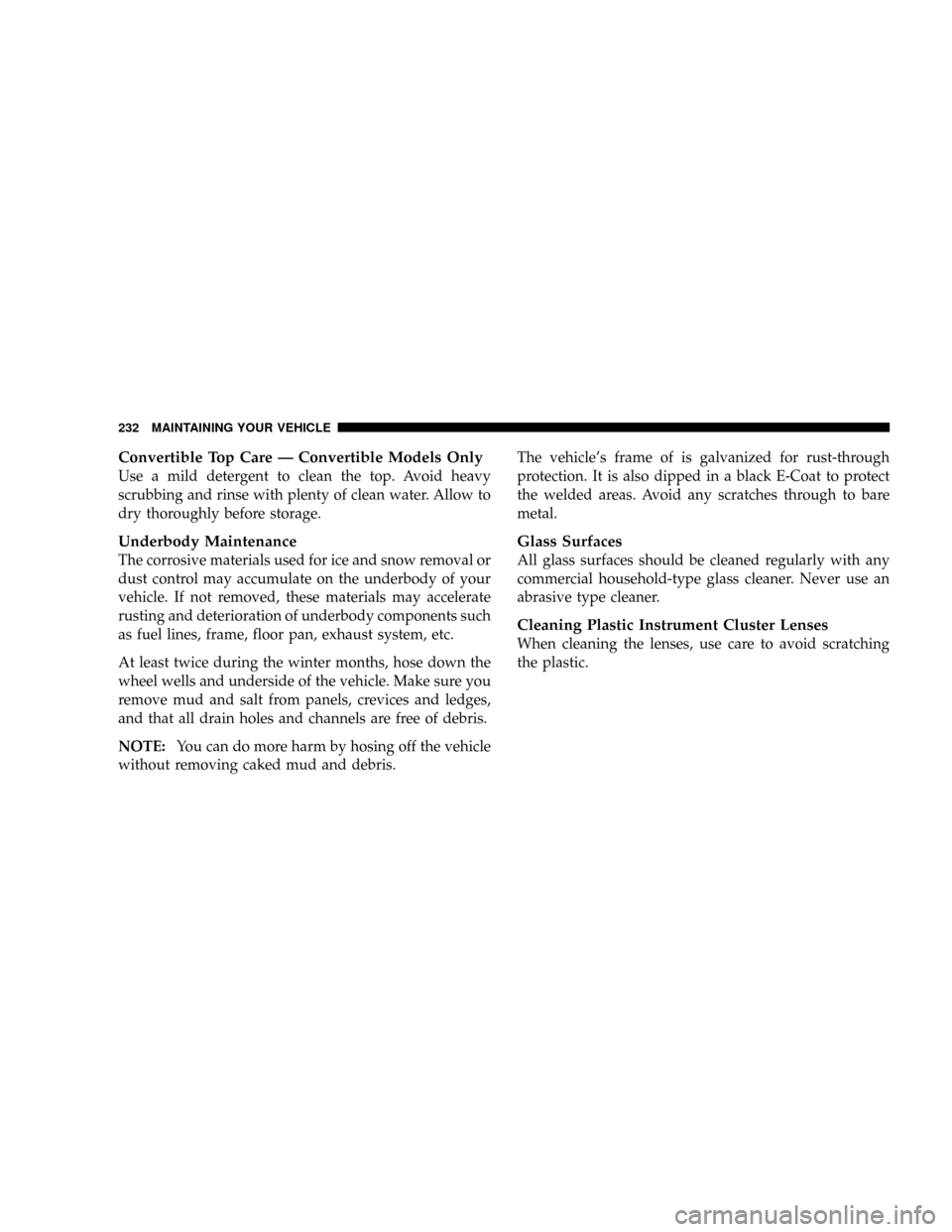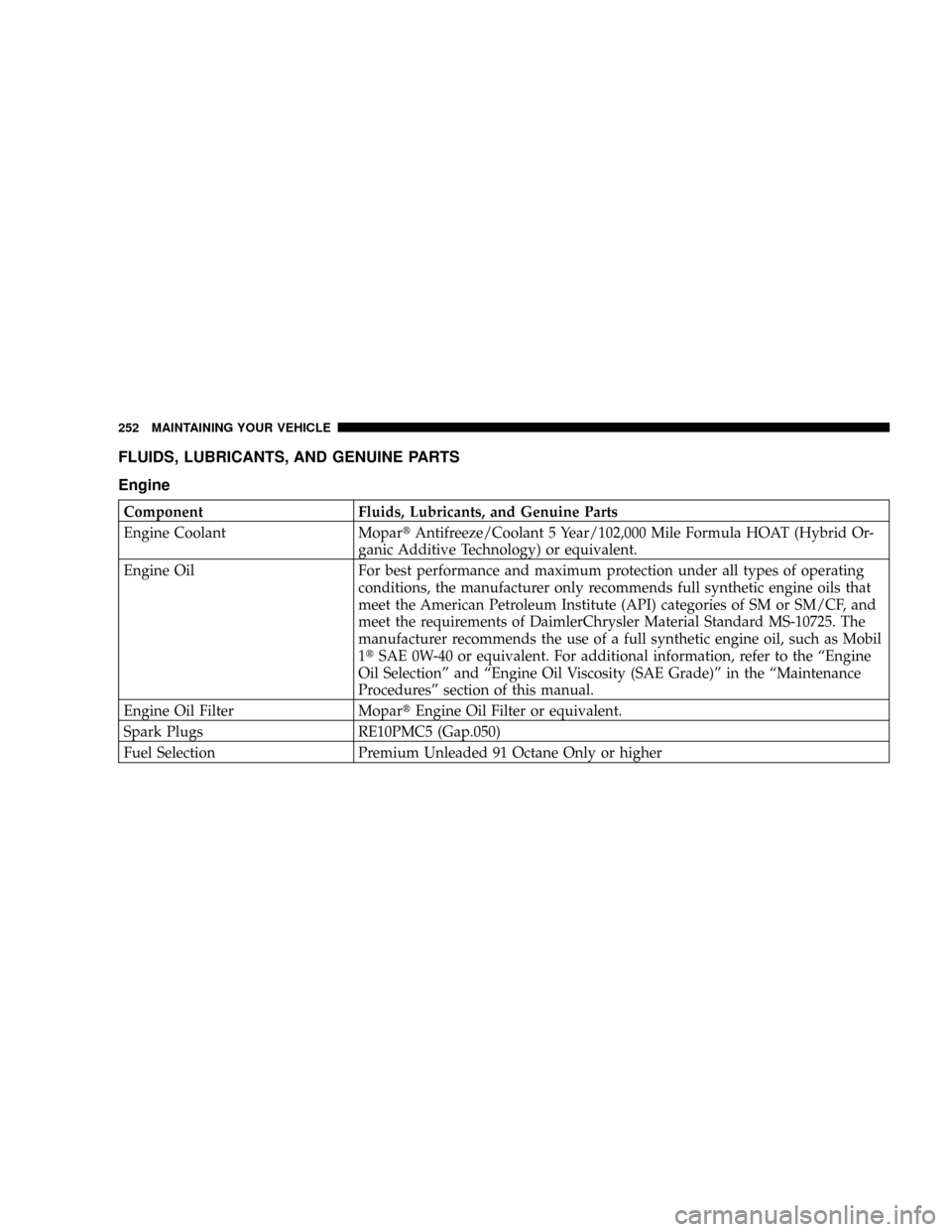fuel type DODGE VIPER 2008 ZB II / 2.G Owners Manual
[x] Cancel search | Manufacturer: DODGE, Model Year: 2008, Model line: VIPER, Model: DODGE VIPER 2008 ZB II / 2.GPages: 303, PDF Size: 2.65 MB
Page 136 of 303

If Engine Fails to Start
CAUTION!
To prevent damage to the starter, do not crank the
engine for more than 15 seconds at a time. Wait 10 to
15 seconds before trying again.
WARNING!
²Never pour fuel or other flammable liquid into the
throttle body air inlet opening in an attempt to
start the vehicle. This could result in flash fire
causing serious personal injury.
²Do not attempt to push or tow your vehicle to get
it started. Unburned fuel could enter the catalytic
converter and once the engine has started, ignite
and damage the converter and vehicle. If the
vehicle has a discharged battery, booster cables
may be used to obtain a start from a booster
battery or the battery in another vehicle. This type
of start can be dangerous if done improperly, so
follow this procedure carefully. See section 6 of
this manual for jump starting instructions.
STARTING AND OPERATING 135
5
Page 159 of 303

2. EconomyÐ
Improper inflation pressures can cause uneven wear
patterns to develop across the tire tread. These abnormal
wear patterns will reduce tread life resulting in a need for
earlier tire replacement. Under inflation, also increases
tire rolling resistance and results in higher fuel consump-
tion.
3. Ride Comfort and Vehicle StabilityÐ
Proper tire inflation contributes to a comfortable ride.
Over inflation produces a jarring and uncomfortable ride.
Tire Inflation Pressures
The proper cold tire inflation pressure is listed either on
the face of the driver's door or on the driver's side ªBº
pillar.
Some vehicles may have Supplemental Tire Pressure
Information for vehicle loads that are less than themaximum loaded vehicle condition. These pressure con-
ditions will be found in the ªSupplemental Tire Pressure
Informationº section of this manual.
The pressure should be checked and adjusted as well as
inspecting for signs of tire wear or visible damage at least
once a month. Use a good quality pocket-type gauge to
Tire Placard Location
158 STARTING AND OPERATING
Page 187 of 303

JUMP-STARTING PROCEDURES
WARNING!
²Take care to avoid the radiator cooling fans whenever the hood
is raised. They can start anytime the ignition switch is on. You
can be hurt by the fans.
²Take care to avoid the accessory drive whenever the hood is
raised. You can be hurt by the moving components.
²Do not attempt to push or tow your vehicle to get it started.
Unburned fuel could enter the catalytic converter and once the
engine has started, ignite and damage the converter and
vehicle. If the vehicle has a discharged battery, booster cables
may be used to obtain a start from a booster battery or the
battery in another vehicle. This type of start can be dangerous
if done improperly, so follow this procedure carefully.
²Battery fluid is a corrosive acid solution; do not allow battery
fluid to contact eyes, skin, or clothing. Don't lean over battery
when attaching clamps or allow the clamps to touch each
other. If acid splashes in eyes or on skin, flush contaminated
area immediately with large quantities of water.
²A battery generates hydrogen gas, which is flammable and
explosive. Keep flame or spark away from the vent holes.
²Do not use a booster battery or any other booster source with
an output that exceeds 12 volts.
NOTE:The battery is located underneath an access
panel inside the rear compartment on the left side of the
vehicle. A remote battery terminal is located in the engine
compartment for jump-starting.
1. Wear eye protection and remove any metal jewelry
such as watchbands or bracelets that might make an
inadvertent electrical contact.
2. When boost is provided by a battery in another
vehicle, park that vehicle within booster cable reach, but
without allowing the vehicles touch one another.
3. Set the parking brake, place the transmission in neu-
tral, and turn the ignition OFF on both vehicles.
4. Turn off the heater, radio, and all unnecessary electri-
cal loads.
186 WHAT TO DO IN EMERGENCIES
Page 201 of 303

²More than 50% of your driving is at sustained high
speeds during hot weather, above 90ÉF (32ÉC)
²Trailer towing
²Taxi, Police, or delivery service (commercial service)
²Off-road or desert driving
²If equipped for and operating with E-85 (ethanol) fuel
NOTE:IfANYof these apply to you, then change your
engine oil every 3,000 miles (5 000 km) or 3 months,
whichever comes first, and follow schedule ªBº in the
9Maintenance Schedules9in this manual.
If none of these applies to you, then change your engine
oil at every interval shown on schedule9A9in the
9Maintenance Schedules9in this manual.
NOTE:Under no circumstances should oil change in-
tervals exceed 6,000 miles (10 000 km) or 6 months,
whichever comes first.
Engine Oil Selection
For best performance and maximum protection under all
types of operating conditions, the manufacturer only
recommends full synthetic engine oils that meet the
American Petroleum Institute (API) categories of SM or
SM/CF, and meet the requirements of DaimlerChrysler
Material Standard MS-10725.
The manufacturer recommends the use of a full synthetic
engine oil, such as Mobil 1tSAE 0W-40 or equivalent.
Engine Oil Viscosity (SAE Grade)
The proper SAE viscosity grade of engine oil should be
selected based on the following recommendation and be
within the operating temperature shown in the engine oil
viscosity chart.
200 MAINTAINING YOUR VEHICLE
Page 225 of 303

²Do not change the thermostat for summer or winter
operation. If replacement is ever necessary, install
ONLY the correct type thermostat. Other designs may
result in unsatisfactory coolant performance, poor gas
mileage, and increased emissions.
Hoses and Vacuum/Vapor Harnesses
Inspect surfaces of hoses and nylon tubing for evidence
of heat and mechanical damage. Hard or soft spots,
brittle rubber, cracking, checking, tears, cuts, abrasions,
and excessive swelling suggest deterioration of the rub-
ber.
Pay particular attention to those hoses nearest to high
heat sources such as the exhaust manifold. Inspect hose
routing to be sure hoses do not come in contact with any
heat source or moving component, which may cause heat
damage or mechanical wear.
Insure nylon tubing in these areas has not melted or
collapsed.Inspect all hose connections such as clamps and cou-
plings to make sure they are secure and no leaks are
present.
Components should be replaced immediately if there is
any evidence of degradation that could result in failure.Fuel System
High pressure fuel system hoses have unique material
characteristics that provide adequate sealing and resist
attack by deteriorated gasoline.
Use only manufacturer specified hoses or their equiva-
lent in material and specification, in any fuel system
servicing. It is mandatory to replace all clamps that have
been loosened or removed during service.
224 MAINTAINING YOUR VEHICLE
Page 233 of 303

Convertible Top Care Ð Convertible Models Only
Use a mild detergent to clean the top. Avoid heavy
scrubbing and rinse with plenty of clean water. Allow to
dry thoroughly before storage.
Underbody Maintenance
The corrosive materials used for ice and snow removal or
dust control may accumulate on the underbody of your
vehicle. If not removed, these materials may accelerate
rusting and deterioration of underbody components such
as fuel lines, frame, floor pan, exhaust system, etc.
At least twice during the winter months, hose down the
wheel wells and underside of the vehicle. Make sure you
remove mud and salt from panels, crevices and ledges,
and that all drain holes and channels are free of debris.
NOTE:You can do more harm by hosing off the vehicle
without removing caked mud and debris.The vehicle's frame of is galvanized for rust-through
protection. It is also dipped in a black E-Coat to protect
the welded areas. Avoid any scratches through to bare
metal.
Glass Surfaces
All glass surfaces should be cleaned regularly with any
commercial household-type glass cleaner. Never use an
abrasive type cleaner.
Cleaning Plastic Instrument Cluster Lenses
When cleaning the lenses, use care to avoid scratching
the plastic.
232 MAINTAINING YOUR VEHICLE
Page 253 of 303

FLUIDS, LUBRICANTS, AND GENUINE PARTS
Engine
Component Fluids, Lubricants, and Genuine Parts
Engine Coolant MopartAntifreeze/Coolant 5 Year/102,000 Mile Formula HOAT (Hybrid Or-
ganic Additive Technology) or equivalent.
Engine Oil For best performance and maximum protection under all types of operating
conditions, the manufacturer only recommends full synthetic engine oils that
meet the American Petroleum Institute (API) categories of SM or SM/CF, and
meet the requirements of DaimlerChrysler Material Standard MS-10725. The
manufacturer recommends the use of a full synthetic engine oil, such as Mobil
1tSAE 0W-40 or equivalent. For additional information, refer to the ªEngine
Oil Selectionº and ªEngine Oil Viscosity (SAE Grade)º in the ªMaintenance
Proceduresº section of this manual.
Engine Oil Filter MopartEngine Oil Filter or equivalent.
Spark Plugs RE10PMC5 (Gap.050)
Fuel Selection Premium Unleaded 91 Octane Only or higher
252 MAINTAINING YOUR VEHICLE